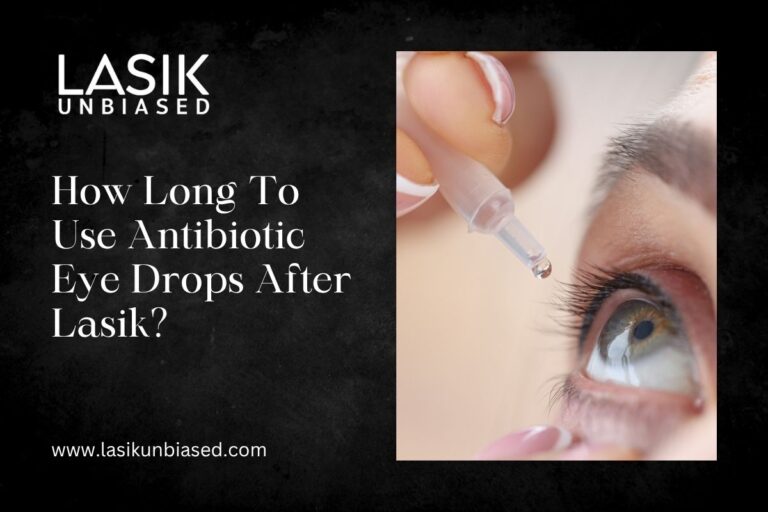Most patients need to use antibiotic eye drops for about 7 to 10 days after LASIK surgery, but your exact duration may vary based on your surgeon’s instructions and your individual healing process.
Stopping too early or using them for longer than prescribed can affect your recovery and eye health, so always follow your doctor’s guidance closely.
LASIK surgery offers the promise of clearer vision, but the journey doesn’t end when you leave the operating room. The time right after surgery is crucial for healing, and antibiotic eye drops play a pivotal role in shielding your eyes from potential infections. If you’re wondering exactly how long to use these drops, you’re not alone. Let’s break down what you can expect, why these drops matter, and how to use them for the best results.
Why Are Antibiotic Eye Drops Prescribed After LASIK?
Antibiotic eye drops are essential for preventing infection while your eyes heal from LASIK. The procedure creates a temporary flap in your cornea, making your eyes more vulnerable to bacteria until the tissue seals and recovers. Antibiotic drops act as a shield, reducing the risk of infection during this crucial window.
- Common antibiotics prescribed: Moxifloxacin, Ofloxacin, or similar broad-spectrum agents.
- Typical use: Four times daily, starting immediately after surgery.
Standard Duration: How Long Should You Use Antibiotic Drops?
General Recommendation
- Most patients use antibiotic eye drops for 7 to 10 days following LASIK surgery.
- The exact length may be shorter or longer based on your surgeon’s protocol, the complexity of your procedure, and how quickly your eyes heal.
Why Not Longer or Shorter?
- Stopping early: Increases your risk of infection, which can threaten your vision.
- Using too long: May lead to antibiotic resistance or disrupt your eye’s natural bacterial balance.
Always follow your surgeon’s instructions, even if your eyes feel fine before the end of the prescribed period.
What Factors Can Affect Your Antibiotic Drop Schedule?
- Surgical complexity: More involved LASIK procedures may require a longer course of antibiotics.
- Healing speed: If your healing is slower than average, your doctor may extend your drop regimen.
- Medical history: Pre-existing conditions or a history of eye infections can influence your doctor’s advice.
Your doctor will monitor your healing during follow-up visits and may adjust your schedule as needed.
What Is the Typical Eye Drop Routine After LASIK?
| Type of Drop | Duration | Typical Frequency | Purpose |
| Antibiotic | 7–10 days | 4 times daily | Prevent infection |
| Steroid (anti-inflammatory) | 1–2 weeks | 4 times daily (tapering) | Reduce swelling, aid healing |
| Artificial tears | Weeks to months | As needed (often hourly) | Relieve dryness, comfort |
Tip: Wait at least 5 minutes between different types of drops to avoid washing one out with another.
How to Use Antibiotic Eye Drops Correctly?
- Be sure to wash your hands thoroughly before coming into contact with your eyes or handling the dropper.
- Tilt your head back and gently pull down your lower eyelid.
- Hold the dropper close (but don’t touch your eye) and squeeze one drop into the pocket.
- Close your eyes gently for 30 seconds to allow the medication to spread.
- Avoid blinking or rubbing your eyes right after applying drops.
Only use the prescribed amount—using more won’t speed up healing and can cause waste or side effects.
What to Do If You Miss a Dose or Encounter Side Effects
- Missed dose: Apply as soon as you remember, but skip if it’s almost time for your next scheduled dose. Don’t double up.
- Mild side effects: Temporary stinging or blurred vision is common and usually fades quickly.
- Severe reactions: If you notice pain, swelling, severe redness, or signs of an allergic reaction, stop using the drops and contact your doctor immediately.
When Should You Stop Using Antibiotic Drops?
Stop only when your doctor tells you to. Even if your eyes feel normal, the tissue may still be vulnerable to infection. Using drops longer than prescribed can also cause issues like resistance or irritation.
What Happens After You Finish the Antibiotic Drops?
- Keep using lubricating (artificial tear) drops as instructed—these may be necessary for several weeks or even months to help relieve dryness.
- Steroid drops may be continued for a few days or weeks after antibiotics, often on a tapering schedule to prevent rebound inflammation.
- Attend all follow-up appointments so your doctor can monitor healing and catch any complications early.
Key Takeaways
- Most patients use antibiotic eye drops for 7–10 days after LASIK.
- Always follow your surgeon’s specific instructions—even if your eyes feel normal.
- Do not stop early or extend use without medical advice.
- Proper use of antibiotic drops is essential for preventing infection and supporting safe healing.
If you’re unsure about your eye drop routine or notice any unusual symptoms, reach out to your eye surgeon right away. Remember, your post-LASIK care is just as vital as the surgery itself—protect your vision by carefully following all instructions.
Common Questions About Using Antibiotic Eye Drops After LASIK
Can I stop using antibiotic drops if my eyes feel fine?
No—finish the full course unless your doctor says otherwise. Stopping early can increase your infection risk.
What should I do if I accidentally use the drops for longer than prescribed?
Prolonged use can disrupt your eye’s natural bacteria and may cause resistance. If you’ve used them longer than prescribed, let your doctor know.
Are there long-term risks with antibiotic eye drops?
When used as directed, long-term risks are very rare. Most side effects are mild and temporary.
Can you safely use additional eye drops at the same time?
Yes, but wait several minutes between different drops to avoid dilution or interaction.


